ISDS 351 Exam 1
1/76
Name | Mastery | Learn | Test | Matching | Spaced |
|---|
No study sessions yet.
77 Terms
What is an information system and why do we need them?
It is a solution that helps us gather, analyze, maintain, and distribute data. It consists of hardware, software, and various networks that are often used by people and organizations to streamline workflows and achieve business goals.
What are the four types of information systems?
-Personal information system: improves productivity of individual users in performing stand alone tasks
-Workgroup information systems: enables people to work together efficiently and effectively
-Enterprise information systems: facilitates organization-wide business needs
-Inter-organizational information systems: enables sharing of information across organizational boundaries
Distinguish between Business Process Reengineering and Continuous Improvement. Which of these would be classified as a project and why?
Business Process Reengineering: radical redesign of business processes, organizational structures, information systems and values of the organization
Continuous improvement: form of innovation that involves constantly seeking ways to improve business processes and add value to products and services
BPR can be classified as a project because it involves a defined beginning and end, specific objectives, and substantial resource allocation. It often requires project management methodologies to coordinate the various aspects of the redesign process.
Define the term database and identify four activities performed by a database management system
A database is an organized collection of structured information or data, typically stored electronically in a computer system. Databases are managed by Database Management Systems (DBMS), which allow users to create, retrieve, update, and manage data efficiently.
Activities Performed by a Database Management System (DBMS)
1 Data Storage and Retrieval: The DBMS provides a systematic way to store data and retrieve it efficiently using queries, often through a language like SQL.
2 Data Manipulation: It allows users to perform operations such as inserting, updating, and deleting records. This manipulation is essential for maintaining current and accurate information.
3 Data Security and Access Control: The DBMS manages user access to the data, ensuring that sensitive information is protected and that only authorized users can access or manipulate it.
4 Backup and Recovery: The DBMS provides mechanisms for backing up data to prevent loss in case of hardware failure or other issues. It also facilitates data recovery processes to restore data to its previous state.
Wha are the three primary characteristics associated with big data
1. Volume
• Definition: Refers to the vast amounts of data generated every second from various sources, including social media, sensors, transactions, and more.
• Importance: The sheer scale of data requires specialized storage and processing solutions, such as distributed databases and cloud storage, to handle and analyze effectively.
2. Velocity
• Definition: The speed at which data is generated, processed, and analyzed. This includes real-time or near-real-time data streams.
• Importance: High velocity demands rapid processing capabilities to derive insights quickly, which is crucial for time-sensitive decisions in areas like finance, marketing, and operations.
3. Variety
• Definition: Refers to the different types of data being generated, including structured data (like databases), semi-structured data (like JSON or XML), and unstructured data (like text, images, and videos).
• Importance: Variety presents challenges for data integration and analysis, requiring advanced techniques to process and extract valuable insights from disparate data formats.
These characteristics highlight the complexity and opportunities presented by big data, influencing how organizations approach data management, analysis, and decision-making.
What are the ACID properties of an SQL databse and what re their benefits?
The ACID properties are a set of principles that ensure reliable processing of database transactions in an SQL database.
Atomicity
• Definition: A transaction is treated as a single, indivisible unit. It either completes in full or has no effect at all.
• Benefit: This ensures that partial updates do not occur; if a transaction fails, the database remains unchanged, preventing data corruption.
2. Consistency
• Definition: A transaction must bring the database from one valid state to another valid state, maintaining all defined rules, such as constraints and triggers.
• Benefit: This guarantees that any transaction will always leave the database in a valid state, upholding data integrity throughout operations.
3. Isolation
• Definition: Transactions are executed in isolation from one another. Concurrent transactions do not interfere with each other.
• Benefit: This prevents data anomalies and ensures that intermediate transaction results are not visible to other transactions, leading to consistent results even in concurrent environments.
4. Durability
• Definition: Once a transaction is committed, its effects are permanent, even in the case of a system failure.
• Benefit: This guarantees that completed transactions are saved and will survive crashes or failures, providing reliability in data storage.
Summary of Benefits
• Data Integrity: ACID properties help maintain accurate and consistent data throughout transactions.
• Reliability: Users can trust that transactions are processed correctly and that the database state reflects those transactions.
• Concurrent Access: Isolation allows multiple users to work with the database simultaneously without conflicts.
• Failure Recovery: Durability ensures that data remains safe and recoverable after system failures.
Overall, ACID properties are crucial for the robust functioning of SQL databases, especially in environments requiring high reliability and data integrity.
3 categories of business intelligence and analytics tools
. Descriptive Analytics Tools
• Description: These tools provide insights into past performance by summarizing historical data. They use statistical analysis and data aggregation techniques to create reports and dashboards that help organizations understand what has happened.
• Examples: Tools like Tableau, Microsoft Power BI, and Google Data Studio are commonly used to visualize historical data and generate reports that aid in decision-making.
2. Predictive Analytics Tools
• Description: Predictive analytics tools leverage historical data, statistical algorithms, and machine learning techniques to forecast future trends and behaviors. They help organizations anticipate outcomes and make informed decisions.
• Examples: Tools such as IBM SPSS, SAS, and RapidMiner are designed to analyze patterns and predict future scenarios, enabling businesses to identify opportunities and risks proactively.
3. Prescriptive Analytics Tools
• Description: These tools provide recommendations for actions based on data analysis. They go a step further than predictive analytics by suggesting optimal solutions and strategies to achieve desired outcomes.
• Examples: Tools like IBM Watson, Oracle Analytics, and Microsoft Azure Machine Learning offer capabilities to simulate various scenarios and recommend actions based on analytical insights.
Summary
Each category serves a distinct purpose:
• Descriptive Analytics helps organizations understand past performance.
• Predictive Analytics aids in forecasting future trends.
• Prescriptive Analytics provides actionable recommendations to optimize decision-making. Together, these tools empower organizations to harness data effectively for strategic advantage.
Leavitt’s Diamond Model
Used to introduce new systems into workplace, lower stress , encourage teamwork and increase implementation
4 key components: People, Technology, Processes, Structure
Value Chain
A series of activities to transform inputs into outputs
Inbound Logistics
Operations
Outbound Logistics
Marketing and Sales
Services
Strategic Planning
The managerial process designed to identify initiatives and projects to achieve organizational objectives
Benefits? Provides framework and direction to guide decision making, provides effective use of organizations resources, allows organization to be proactive and improve communication
IS Strategic Planning
Identifies resources to invest in, supports corporate and business unit strategies, includes technologies, vendors, competencies, people, systems, and projects
influences new technology innovations and innovative thinkers
Shadow IT
The use of IT-related systems, software, or hardware without the knowledge or authorization of an organization's IT department. It can include the use of cloud services, software, and hardware.
Typical IS Roles
Chief Information Officer -employs IS dept equipment and personnel, achieves organizations goals, understands finance, accounting and ROI
Software Developer - develops apps and operation systems, tests and debugs and upgrade software
IS Security Analyst - consults with management and iusers, defines scope and requirements for new information systems
Programmer- converts design into working program
Web Developer- design and maintain websites, monitor websites
Business Analyst- improve company’s competitiveness and performnce, evaluate and solce business challenges
Certification
The process for testing skills and knowledge confirming individual is capable of performing particular tasks involving vender-specific or vendor-provided coursework
3 Approaches to Strategic Planning
Issues based - identify/ analyze key issues, set strategies to address them, and identify consistent projects and initiatives
Organic Strategic planning - define visions and values and identify projects and initiatives to achieve vision while adhering to values
Goals-based strategic planning- 4 phases: Analyze the Situation, Set Direction, Define Strategies, Deploy the Plan
Five Forces Model
Used to analyze the performance of an industry and determine its competitiveness
1.Threat of new entrants
2.Bargaining power of buyers
3.Bargaining power of suppliers
4.Threat of new substitutes
5.Competitive rivalry
SWOT Analysis
a strategic planning tool that evaluates an organization's internal and external factors to identify strengths, weaknesses, opportunities, and threats
5 Project Classifications
1. Strategic: aligned with organization long term goals and objectives, high impact, involves significant resources
2. Compliance: focused on meeting legal, regulatory, or industry standards.
3. Operational: aim to improve efficiency, productivity, and effectiveness of orgs daily operations
4. Financial: focus on optimizing financial performance, managing resources or improving financial controls
5. Technological: involve development, implementation or enhancement of technology systems
Innovation
Application of new ideas to the products, processes and activities of a firm, leading to increased value
ex: Apple, UBER, Amazon, AirBNB
Reengineering
radical redesign of business processes, organizational structures, information systems and values of the organization
Continuous improvement
form of innovation that involves constantly seeking ways to improve business processes and add value to products and services
Strategic Planning Pyramid
a top-down approach to identify initiatives, programs, and projects that are well-suited for the organization.
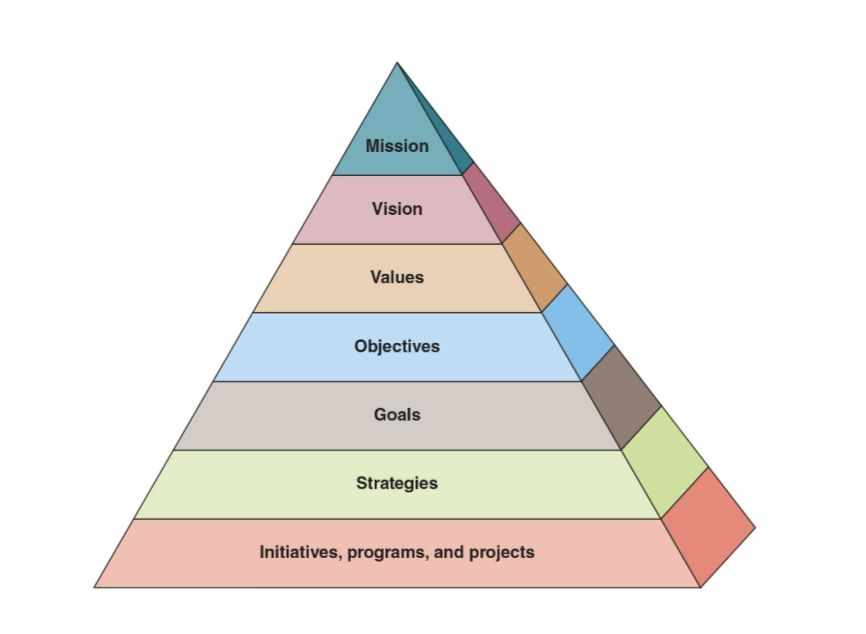
Organizational Culture and Change
the set of values, beliefs, and norms that define a company's identity and influence how it operates. Organizational culture change is the process of intentionally altering a company's culture to align it with its desired values and goals
TAM Acceptance Model
Specifies the factors that can lead to better attitudes about the use of a new information system, along with its higher acceptance and usage
Perceived usefulness (U) and perceived ease of use (E) strongly influence whether someone will use an information system. Management can improve that perception by demonstrating that others have used the system effectively and by providing user training and support.

Diffusion of Innovation Theory
explains how a new idea or product gains acceptance and diffuses (or spreads) through a specific population or subset of an organization
Key point: adoption of any innovation does not happen all at once for all members of the targeted population; rather, it is a drawn-out process, with some people quicker to adopt the innovation than others
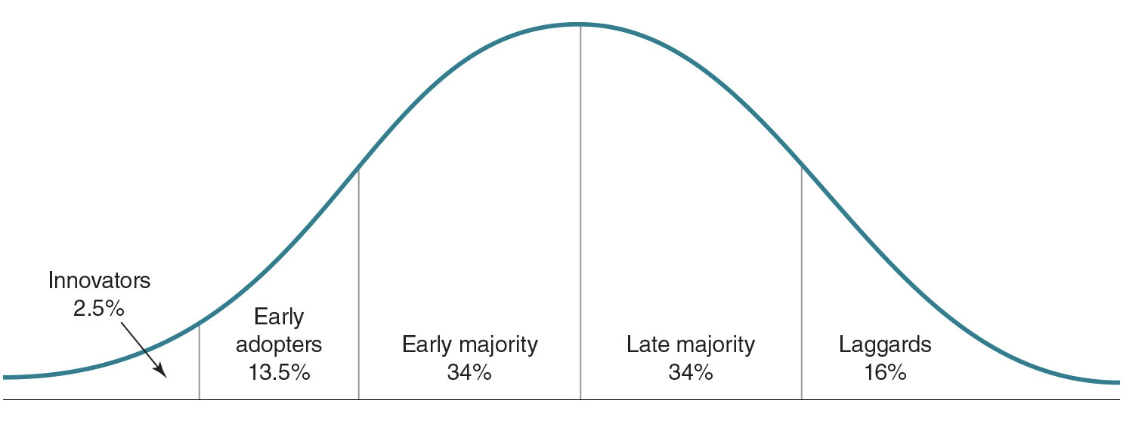
Project Management
the process of planning, organizing, and executing a project to achieve a specific goal or outcome
5 Paramters that define a project
Scope:Definition of which tasks are included and which tasks are not included in a project
Cost:Includes all capital, expenses, and internal cross-charges associated with the project’s buildings, operation, maintenance, and support
Time:Timing of a project is frequently a critical constraint
Quality: Degree to which the project meets the needs of its users
User Expectation:As a project begins, stakeholders will form expectations—or will already have expectations—about how the project will be conducted and how it will affect them
Outsourcing
the practice of hiring a party outside a company to perform services or create goods
Offshore Outsourcing
a business strategy where a company hires a third-party provider in a foreign country to perform tasks that are usually done in-house
Reasons for outsourcing
cut/stabilize costs, improve the firm's focus on core operations, upgrade the firm's capabilities and services, accelerated time to market
Issues with outsourcing
- Lowering of employee morale due to layoffs
-Quality issues rise as outsourcing is associated
with significant risks
-Ending outsourcing agreements prematurely
generates expensive legal fees
-Direct communication between a company and its
customers is reduced
-Maintaining data security and integrity to safeguard
against data security lapses
Special Issues associated with outsourcing
-Language barrier
-Multiple time zones and inability to meet face-to-
face
-Jurisdiction
-Data privacy
-Diminishing cost advantages
-Turnover
- Intellectual property rights
-Important technology issues
Cloud Computing
Hardware and software resources available to users over the Internet
Public Cloud Computing :Service provider organization owns and manages the infrastructure
– Cloud user organizations (called tenants) access
slices of shared hardware resources via the Internet
– Faster, cheaper, and more agile approach to building
and managing one’s own IT infrastructureHybrid: includes both private and public clouds integrated through networking
– Used by organizations to run applications with less
sensitive security requirementsPrivate:Single tenant cloud
– Types
• On-premise private cloud
• Virtual private cloud
3 Fundamental Cloud Types
Saas - Software as a service
-ex:Salesforce.com, iCloud, Office 365
PaaS - Platform as a service
-ex: Microsoft Azure, Oracle on Demand
IaaS - Infrastructure as a service
-ex: AmazonEC2 (elastic cloud 2), AmazonS3(SimpleStorageService)
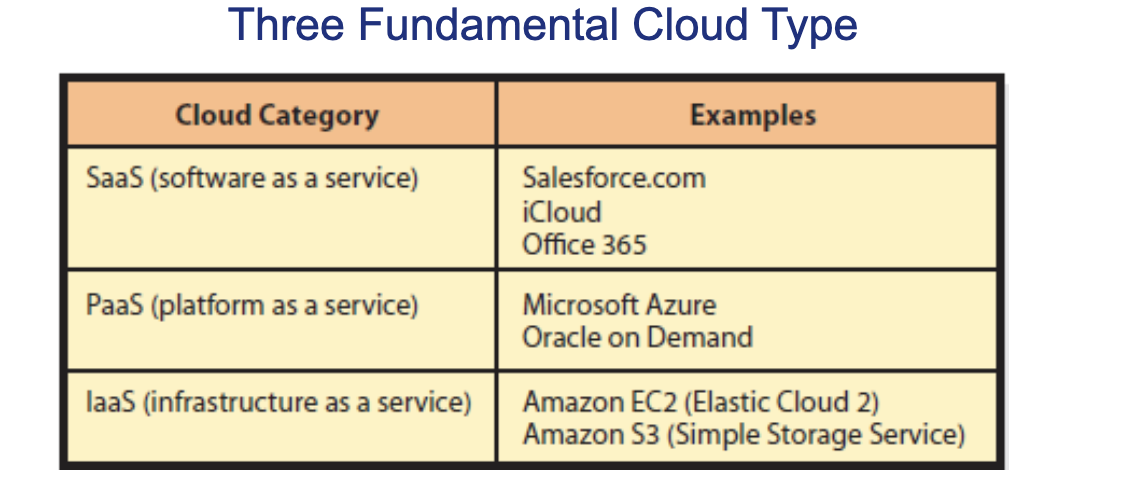
What is data?
Raw facts
What is information?
-Collection of organized and processed data
-Has additional value beyond the value of the
individual facts
What is knowledge?
• Provides awareness and understanding of a
set of information
• Shows how information can support a specific
task or be used to reach a decision
8 characteristics of High Quality Data
Accessible -Information should be easily accessible by authorized users so they can obtain it in the right format and at the right time to meet their needs.
Accurate - Accurate information is error free.
Complete - Complete information contains all the important facts
Economical - Information should also be relatively economical to produce.
Relevant - Relevant information is important to the decision maker.
Reliable- Reliable information can be trusted by users.
Timely - Timely information is delivered when it is needed
Verifiable -Information should be verifiable.
Benefits gained through use of high quality data
Improves decision making
increases customer satisfaction
increase sales
improves innovation
raises productivity
ensure compliance
Data Hierarchy
Database
File- collection of entities
Entity- person, place or thing for which data is collected, stored and maintained
Attribute - characteristic of an entity
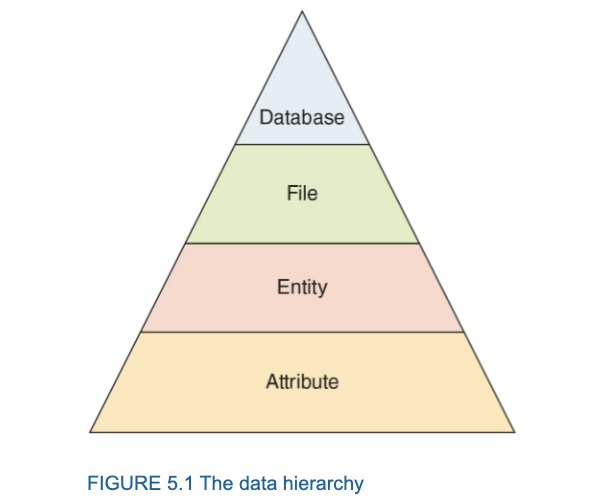
Domain
Range of allowable values for a data attribute
Data item
Specific value of a data attribute
Record
Collection of attributes about a specific entity
Primary Key
Attribute or set of attributes that uniquely identifies the record
Foreign Key
Attribute in one table that refers to the primary key in another table
Schema - DBMS
a blueprint that defines the logical structure of a database, including how data is organized and stored
Storing and retrieving data - DBMS
a two part process which involves the storage of data on some kind of storage medium so it can be preserved and then later retrieved for use by another process at a later time
Concurrency Control - DBMS
a process that manages multiple transactions accessing shared data in a database management system (DBMS) simultaneously
ensures that simultaneous transactions on a DBMS do not interfere with each other
Security Management- DBMS
the collection of processes and procedures used to protect and secure a database or database management software from illegitimate activity and use, malicious threats, and attacks
Ensures data is protected against access by:
• Unauthorized users, physical damage, operating
system failure, and simultaneous updating
Backup and Recovery- DBMS
the process of making copies of data and restoring them to a safe location if the original data is lost or damaged
Data Cleansing
Detects and then corrects or deletes incomplete, incorrect, inaccurate, or irrelevant records residing in a database
Methods:
cross-checking with a validated data set
data enhancement is data is made more complete by adding related information
Data Modeling
the process of creating a visual representation of an organization's data, including how it's collected, stored, and used
Enterprise Data Model
a visual representation of an organization's data that shows how it's structured and organized
• Identifies data entities and data attributes of
greatest interest to the organization
• Identifies their associated standard data
definitions, data length and format, domain of valid
values, and any business rules for their use
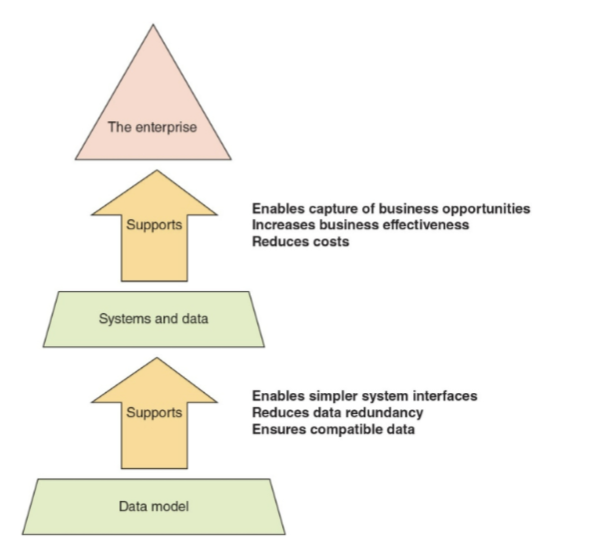
Entity Relationship (ER) Diagram
a visual representation of how entities relate to each other in a system, typically a database, development of ER diagrams helps ensure that the logical structure of application programs is
consistent with the data relationships in the database
• Data model used to analyze and communicate data needs
• Works at the individual project or application level
• Uses graphical symbols
• Identify data entities and their associated data attributes
• Identify the relationships among the entities of interest

Relational Database
a type of database that organizes data in tables to make it easier to understand and access how different data points relate to each other
Characteristics:
Tables
Data is organized into tables, with each row representing a record and each column representing an attribute.
Relationships
Logical connections are established between tables based on how they interact with each other.
ACID properties
Relational databases are designed to ensure the accuracy and integrity of data through ACID properties, which stand for Atomicity, Consistency, Isolation, and Durability.
Flexibility
Relational databases are flexible and can be used for a variety of purposes. They are often used in industries such as banking, retail, and entertainment
Manipulating Data in a Relational Database
Selecting
• Selecting records (rows) that satisfy certain
conditionsProjecting
• Selecting attributes (columns) from recordsJoining
• Combining two or more tables through common
data attributes to create a new temporary table
Note: the above 3 do not change the data in
the databaseData normalization
• Eliminates data redundancy
SQL Database
a relational database that stores and organizes data in tables using a structured query language (SQL)
SQL databases conform to ACID properties
SQL is a programming language that allows users to perform operations on the database, such as: Creating data, Retrieving data, Updating data, Deleting data, and Maintaining and optimizing database performance
Database as a service (DaaS)
DaaS is a cost-effective and secure way to provide a virtual desktop environment to users, including operating systems, applications, files, and user preferences. DaaS can help organizations with hybrid work environments, as employees can access their desktops from any device
Data Mangement
Defines the processes by which data is obtained,
certified fit for use, stored, secured, and processedEnsures data accessibility, reliability, and
timeliness meet the data users’ need
Data Governance
• Defines roles, responsibilities, and processes
• Ensures data can be trusted and used by the entire
organization
• Ensures people identified and in place who are
responsible for fixing and preventing issues with data
What is Big Data?
large and complex sets of data that are difficult to manage.
It's characterized by its volume, velocity, and variety, and is so large that traditional data management systems can't process it
Uses and Challenges of Big Data
Uses:
Day to Day Operations
Planning
Decision Making
Challenges:
Too much data - where and what to store
Compliance and Regulations
Privacy Concerns
Data Mart
• Subset of a data warehouse, less than 100GB
• Focused on a line of business, department or subject area
• Used by small and medium-sized businesses and departments within large companies
• Supports decision making
Data Warehouses
• Large database – Terabyte and above
• Holds business information from many sources
in the enterprise
• Covers all aspects of the company’s processes,
products, and customers
A data warehouse can help managers and executives relate information in innovative ways to make better decisions.
Data Lakes
• Takes a “store everything” approach to big data
• Saves all data in its raw and unaltered form
NoSQL Database
a non-relational database that stores data in a flexible format instead of relational tables. NoSQL databases are known for their ability to handle large amounts of unstructured data, and are a popular choice for developers
Features:
Flexible schema
NoSQL databases can store a variety of data types, including documents, key-value, wide columns, and graphs. This makes them ideal for semi-structured and unstructured data.
Scalability
NoSQL databases are designed to scale out by adding more hardware, rather than scaling up by adding more powerful servers.
Performance
NoSQL databases are optimized for specific data models and access patterns, which can lead to better performance than relational databases.
Ease of use
NoSQL databases are known for being easy to develop and use.
Data integrity
NoSQL databases use an approach called BASE (Basically Available, Soft State with Eventual Consistency) to manage data integrity
Four Categories of NoSQL databases
Key-value NoSQL databases
• Two columns (“key” and “value”)Document NoSQL databases
• Store, retrieve, and manage document-oriented
information: semi-structured dataGraph NoSQL databases
• Well-suited for analyzing interconnections between
people, things, etc.Column NoSQL databases
• Store data in columns - each attribute has its own
key-value table leading to faster processing
Hadoop
An open source framework based on Java that manages the storage and processing of large amounts of data for applications
Hadoop uses distributed storage and parallel processing to handle big data and analytics jobs, breaking workloads down into smaller workloads that can be run at the same time
MapReduce Program
a programming model that processes large data sets in parallel by breaking them down into smaller tasks
Consists of two components
• Map procedure performs filtering and sorting
• Reduce method performs a summary operation
Hadoop limitation
• Can only perform batch processing
In Memory Database (IMDB)
a database that stores data in a computer's main memory, instead of on a disk drive, to provide faster response times
Some industries that benefit from in-memory databases include: telecommunications, banking, travel, and gaming
Business Intelligence
• Wide range of applications, practices, and technologies
• Extracts, transforms, integrates, visualizes, analyzes, interprets, and presents data
• Supports improved decision making
Analytics
• Extensive use of data and quantitative analysis
• Supports fact-based decision making within organizations
Benefits from Business Analytics and Intelligence
• Detect fraud
• Improve forecasting
• Increase sales
• Optimize operations
• Reduce costs
Components required for effective BI and Analytics
Existence of a solid data management program
• Includes governanceCreative data scientists
Strong commitment to data-driven decision making
Structured vs. Unstructured Data
Structured data is data that fits neatly into data tables and includes discrete data types such as numbers, short text, and dates.
Unstructured data doesn't fit neatly into a data table because its size or nature: for example, audio and video files and large text documents.
Business Intelligence Tools
1. Microsoft Power BI · 2. Tableau · 3. QlikSense · 4. Dundas BI · 5. Sisense · 6. Microsoft Copilot.
Data Mining Tools
Software applications that utilize statistical and analytical capabilities to process large datasets, identifying patterns, trends, and relationships within the data to support informed decision-making by extracting meaningful insights; essentially "mining" valuable information from the data
1. Python · 2. R · 3. RapidMiner · 4. Orange · 5. Rattle GUI · 6. KNIME · 7. SAS Enterprise Miner.